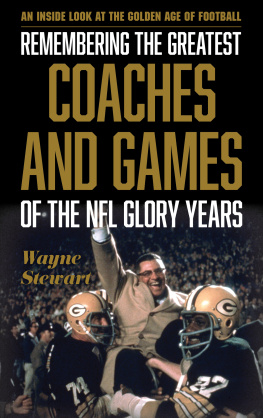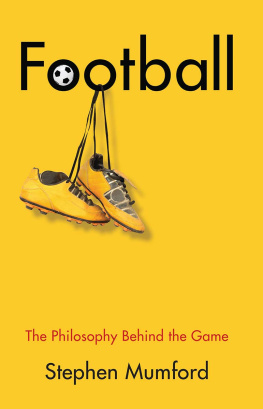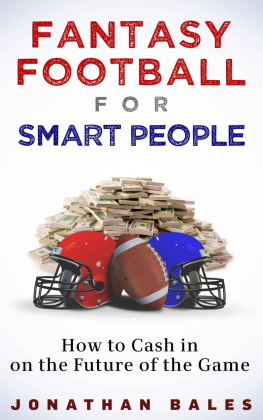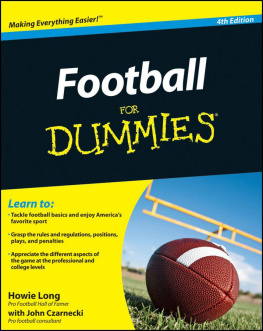Copyright 2012
All rights reserved.
ISBN: 1470125595
ISBN 13: 9781470125592
eBook ISBN: 978-1-62110-586-2
To all the coaches, as I am forever your student.
To Sarah, without whose kindness and patience none of this would be possible.
TABLE OF CONTENTS
F ootball is the greatest team sport because, more than any other, it is truly about the teamwith twenty-two players on the field, eleven to each side, sustained success is only possible if each player does his job and every player works together. This is unlike other sports, which may be, and often are, dominated by an individual. Instead football, by its very nature, teaches everyone who plays it the greatest lesson of all: when you get knocked downand in football, everyone eventually winds up on the turfyou must get up and give it another go. It may be a clich, but if so its one for a reason: in life, all of us must learn to get up and play the next play.
Yet football is also great because, due to its complex arrangements of twenty-two roving players across a wide expanse of green grasscoupled with repeated opportunities for synchronized action and planningit is a sport for those who think. A play may only take up four, maybe five seconds, but unknown and potentially innumerable hours may have gone into its design and preparation; the ideas giving structure and method to that play call may be older than any of the actors, including the coaches. Football is the rare pastime that has the potential to stimulate our left and right brains equally.
This interplay of mind and muscleof the raw physics of bodies flying across a field as a result of some combination of planning, preparation and geometryhas long fascinated me. Of course, we cannot forget that football is a game, and no matter the hyperbole in the media, coaches are not geniuses because they can draw up a pass play, and players are not heroes because they scored a touchdown. Football, despite its complexity, is not chess, and for many, putting too much thought into a game runs into the danger Mark Twain identified with explaining a joke: while we might learn a great deal, our ability to enjoy the thing we are studying may die along the way.
But I am convinced that football is too rich a subject not to be examined in detail. In the essays that follow, I try to speak to two audiences: football coaches and interested fans. And there is more overlap in these two groups than commonly assumed. No coach knows everything about every aspect of football, and there are always new variations, new approaches, new ideas that push the game forward. And there is simultaneously very little in football is that is truly new in and of itself; what is actually new is how the old ideas are synthesized and assembled together, and streamlined in a method that can be taught. And these aspects, those centered around organization, synthesis, and teaching, are things every coach can learn from. Similarly, interested fans may have a variety of backgrounds in footballplayed in high school, played in college, coached little league, or never even played a downbut want to learn more about how the game works. Yes, the quarterback threw a touchdown or an interception, they ask, but why?
Indeed, a great deal of commentary about football revolves around one thing: the assignment of credit or blame on specific players and coaches. And while many have no qualms about performing such judgments with little or no background or analysis, most reasonable people realize very quickly that you need to know at least a little about the game to accurately say, The defensive back blew the coverage or The quarterback made a bad read. And its simply more fun to watch a game with a greater sort of understanding of what is really happening on the field. Anyone can watch a freak-of-nature athlete out-leap other extremely talented people and do something physically miraculous, but its also fun to see that the reason your Fantasy Football running back had a long touchdown run this week was because he ran the counter trey to perfection, that the pulling guard and tackle made their kick-out and pull-and-lead blocks just so and caught the defense out of position.
This is not to say that these pieces can give anyone, let alone a casual fan, a total understanding of the game. Learning football is a lifetime endeavor, and among the chief lessons the game teachesto players and coaches alikeis humility, as success and security are almost always too fleeting. These essays are instead intended to be merely what they are: fun examinations of what makes the game great, with specific focuses on the people, the ideas, the theories, and the history and evolutions of each. I wrote them because they were the kinds of pieces I wanted to read about football. But I also wrote them because they are the least I can do to try and give back in some small way to a game thatdespite its many flaws, and the all-too-brief time any of us have to be around what is ultimately only a gametaught me more about character, teamwork, and, well, life, than anything else Ive been a part of. I can only hope that comes through in the pages that follow.
We become just by performing just actions, temperate by performing temperate actions, brave by performing brave actions.
Aristotle
THE EVOLUTION OF URBAN MEYER AND
HIS SPREAD OPTION OFFENSE

FALL 2008

T he book Spread Formation Football, written by Coach Meyer, begins with the line: Spread formations are not new to football. Very true. Wait, I should have been more specific. Spread Formation Football was written in 1952 by Coach Dutch Meyer of Texas Christian University. Yet that Meyers edict applies with as much force to todays Coach Meyer as it did then, if not more so, and it highlights a simple truth. Urban Meyer and his offensive coordinator at the University of Florida, Dan Mullen, are not geniuses, nor are they innovators. Indeed, Floridas offense is not new; it is not novel; it is not even that unique. Urban Meyer would agree and say thats okay. While his offense may not be new, it is instead something much betterextremely good.
Urban Meyer does not run the wing-t from shotgun (his offense is not based around series football as those offenses are); he does not run the run-and-shoot with more running; and the option is only one part of Meyers offense. Instead, the inspirational fathers of Floridas offense are Joe Gibbs and Dennis Erickson, two coaches who helped establish and pioneer the one-back offense. Indeed, Floridas main run plays are basically the same ones both made popular in the 80s, though from the shotgun and with a bit more option sprinkled in.
Surprised to hear these roots? Meyer is not shy; he admits that he was a late mover to the spread offense. In a time when the newness of the spread has worn off and some spread offenses are awful, we still have Meyers flying circus, complete with his rhinoceros quarterback, Tim Tebow.
Prior to becoming the head coach at Florida, Urban Meyer bounced around as an assistant coach, finally as receivers coach at Notre Dame under the (surprisingly) schematically brilliant but instinctively Cro-Magnon Bob Davie. In his book, Meyer recalled a moment when, after a loss to Nebraska in 2001, he found one of his best players, David Givens, crying at his locker because he felt he had been unable to help his team win: he hadnt touched the ball the entire game. Meyer then swore to run an offense that delivered the ball to his playmakers. While at Notre Dame, Meyer began meeting with his intellectual mentor, Scott Linehan (his professional mentor was, among others, Lou Holtz). (At the time, Scott Linehan was the offensive coordinator at the University of Louisville; he would later become the offensive coordinator for the Minnesota Vikings, the head coach for the St. Louis Rams, and is currently the offensive coordinator for the Detroit Lions.) Meyer was eventually hired as head coach of Bowling Green and decided thatin years that just happened to be the rather formative ones for the spread offensehe would have his staff learn at these underground masters feet.









